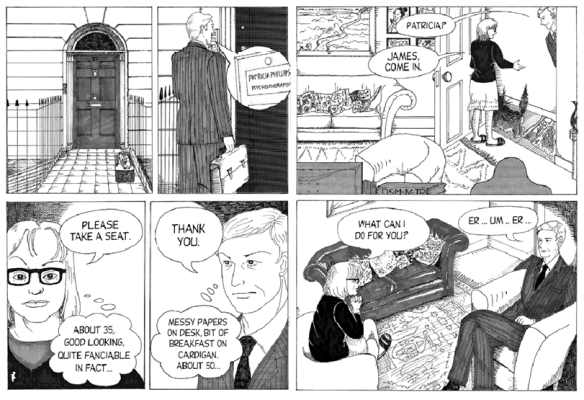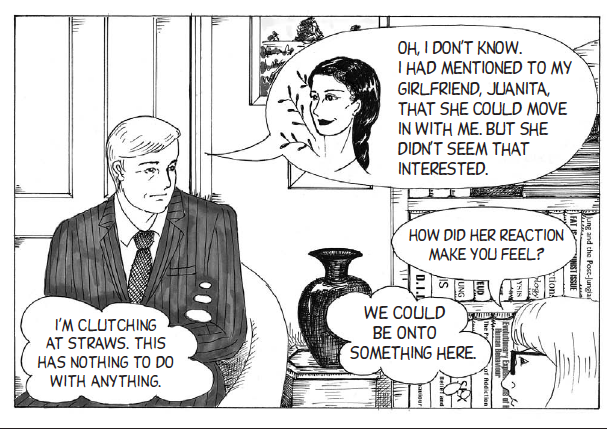Writer: Philippa Perry / Artist: Junko Graat / Publisher
During this quarantine, I find myself looking not only for new comics to read but also older ones to revisit. I, like many others I imagine, have a full bookshelf of tomes that were critically influential at one point in time and survived the culling of many moves just in case one day some mentions something off-hand, and I can excited, “Oh. I have a book that I can loan you.” And as it happened, as I was surveying my shelves for something to reread while lying on my couch this week, I found the appropriately named Couch Fiction.
The book’s full title is Couch Fiction: A Graphic Tale of Psychotherapy, and it is one of the earlier graphic novels I purchased when I was first getting into comics way back in 2010. It certainly also helped that I was an engineering major with a lot of ArtSci friends who were taking Intro to Psychology courses, and I needed something that wasn’t so fixated on numbers and figures. Couch Fiction is not a textbook, but it is written by an actual psychotherapist who penned this imaginary case study that followed one patient throughout the course of their therapy sessions, from the initial intake to the final farewell.

Yet, what distinguishes Couch Fiction is what happens just off panel. Perry has annotations underneath the panel that provides additional and further insight into psychotherapy practices. It’s kind of like a built-in director’s commentary that provides additional insight to the profession and other meandering thoughts. As the different sessions between Pat and James continue, we are treated to what is a compelling tale that unfolds over the course of the year. Perry’s dialog and internal narration is well paced and easy to follow in the main comic, and the additional elaboration at the bottom can help annotate the story the first time around or be saved for a second read.
Graat’s artwork has a clean aesthetic that provides a great scaffolding for the rest of the story and lets the text breath. The facial expressions and background details help ground the work while also having enough ambience to help accentuate the mood. It’s the small things like unconventional thought bubbles, the use of pitch black versus a crosshatch, and small cues littered through. Graat’s art lets us fully grasp the inner thoughts and memories of the principle character that text couldn’t convey simply and give the story further emotional tethering.

Perry presents this story not as an end-all be-all guide but rather an accessible entry point for readers with an interest in the inner workings of psychotherapy. It’s not exhaustive by any means, but it is genuinely compelling tale on its own that does provide a unique window in a profession that has varying degrees of accurate portrayals in mainstream media. It’s an easy read that lets you inhabit and examine the entangled journey of two different characters, while the creator talks to you candidly about how the story came to be. If you’re looking for something just educational enough to peruse, I can strongly recommend Couch Fiction: A Graphic Tale of Psychotherapy.
Want to get Black Nerd Problems updates sent directly to you? Sign up here!
Follow us on Twitter, Facebook and Instagram!



Show Comments